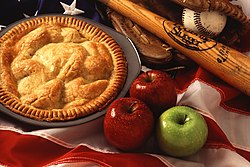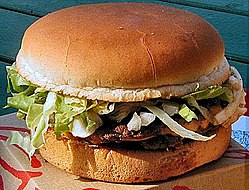American cuisine: Difference between revisions
No edit summary |
|||
| Line 17: | Line 17: | ||
Similarly, while some dishes considered typically American may have their origins in other countries, American cooks and chefs have substantially altered them over the years, to the degree that the dish as now enjoyed the world over may even be considered archetypically American. Hot dogs and hamburgers are both based on traditional [[German Cuisine|German]] dishes, brought over to America by German immigrants to the United States, but in their modern, popular form they are so altered that they can be reasonably considered American dishes. |
Similarly, while some dishes considered typically American may have their origins in other countries, American cooks and chefs have substantially altered them over the years, to the degree that the dish as now enjoyed the world over may even be considered archetypically American. Hot dogs and hamburgers are both based on traditional [[German Cuisine|German]] dishes, brought over to America by German immigrants to the United States, but in their modern, popular form they are so altered that they can be reasonably considered American dishes. |
||
Given the United States' large size it is not surprising that its cuisine is typified by distinct regional variations. The cuisine of the [[East Coast of the United States|East Coast]], for example, makes use of fish and seafood to much greater degree than that of the [[Midwest]], where corn and beef were long more readily available. To some degree, easy transportation of perishable foodstuffs has diminished these regional differences in recent years, but many Americans still associate certain foods with specific places, such as [[steak]] with [[Omaha, Nebraska|Omaha]], [[American lobster|lobster]] with [[Maine]], and [[Blue Crab]] and [[Crabcake]] with Maryland. |
Given the United States' large size it is not surprising that its cuisine is typified by distinct regional variations. The cuisine of the [[East Coast of the United States|East Coast]], for example, makes use of fish and seafood to much greater degree than that of the [[Midwest]], where corn and beef were long more readily available. To some degree, easy transportation of perishable foodstuffs has diminished these regional differences in recent years, but many Americans still associate certain foods with specific places, such as [[steak]] with [[Omaha, Nebraska|Omaha]], [[American lobster|lobster]] with [[Maine]], salmon with Washington, and [[Blue Crab]] and [[Crabcake]] with Maryland. |
||
States far exceeding anything found in their home countries. Furthermore, American cooking has been widely exported beyond its borders. [[Tex-Mex cuisine|Tex-Mex]], [[Louisiana Creole cuisine|Creole]], and barbecue restaurants can be found in cities all around the world, while fast-food burger bars and pizzerias are even more popular. |
States far exceeding anything found in their home countries. Furthermore, American cooking has been widely exported beyond its borders. [[Tex-Mex cuisine|Tex-Mex]], [[Louisiana Creole cuisine|Creole]], and barbecue restaurants can be found in cities all around the world, while fast-food burger bars and pizzerias are even more popular. |
||
Revision as of 22:14, 21 March 2007
Because the United States has long attracted immigrants from a wide variety of nations and cultures, it is no surprise that the cuisine of the United States is extremely diverse and difficult to define. One way of describing American cuisine is a synthesis of cuisines from around the world, a style of cooking that takes something from each immigrant community. On the other hand, American cooks have exported a great variety of dishes around the world, and in many ways American cuisine is just as recognisable and as popular as French, Chinese, or Indian.
Problems with defining American cuisine

The cuisine of the Native Americans was of course the first American cooking style, and it lent a great deal not only to subsequent American cooking but also to culinary styles around the world. Turkey, corn (maize), beans, sunflowers, potatoes, peppers, and various forms of squash (including pumpkins) are among the Native American foods now widely consumed elsewhere. Superimposed on this original native diet is the massive contribution of the various immigrant groups; many dishes considered quintessentially American are in fact based upon the cooking traditions of other countries. For example, apple pies, pizza, runzas, chowder, and hamburgers are all either identical to, or derived from, European dishes. Burritos and tacos similarly have their origins in Mexico.
Another factor that makes defining American cuisine difficult is that much of it is rustic rather than elaborate, some aspects of American food culture are not immediately recognised as cuisine. Salt water taffy, clam chowder, baked beans, barbecue, candy bars, and most fast-food items are some of the better known examples.
The origins of American cuisine

Some describe native plants and game animals in traditional recipes. As a result, one important characteristic of American cooking is the fusion of multiple ethnic or regional approaches into completely new cooking styles. The cuisine of the South, for example, has been heavily influenced by immigrants from Africa, France, and Mexico, among others. Asian cooking has played a particularly large role in American fusion cuisine.
Similarly, while some dishes considered typically American may have their origins in other countries, American cooks and chefs have substantially altered them over the years, to the degree that the dish as now enjoyed the world over may even be considered archetypically American. Hot dogs and hamburgers are both based on traditional German dishes, brought over to America by German immigrants to the United States, but in their modern, popular form they are so altered that they can be reasonably considered American dishes.
Given the United States' large size it is not surprising that its cuisine is typified by distinct regional variations. The cuisine of the East Coast, for example, makes use of fish and seafood to much greater degree than that of the Midwest, where corn and beef were long more readily available. To some degree, easy transportation of perishable foodstuffs has diminished these regional differences in recent years, but many Americans still associate certain foods with specific places, such as steak with Omaha, lobster with Maine, salmon with Washington, and Blue Crab and Crabcake with Maryland.
States far exceeding anything found in their home countries. Furthermore, American cooking has been widely exported beyond its borders. Tex-Mex, Creole, and barbecue restaurants can be found in cities all around the world, while fast-food burger bars and pizzerias are even more popular.
American regional and fusion cuisines
- American Chinese cuisine
- Barbecue
- California cuisine
- Euro-Asian cuisine, a kind of fusion cuisine
- Fast food
- Floribbean
- Cuisine of Kentucky
- Hawaiian cuisine
- Italian American cuisine
- Midwestern cuisine
- Native American cuisine
- New England cuisine
- New York City cuisine
- Pennsylvania Dutch cuisine
- Philadelphia cuisine
- Puerto Rican cuisine
- Southern cuisine
- Southwestern cuisine
Particular American foods

- American Parfait
- Amish Friendship Bread
- Apple Pie
- Boston baked beans
- Brownies
- Buffalo steaks and burgers
- Buffalo Wings
- Cheeseburger
- Cheesesteak
- Chicago-style pizza
- Chili con carne
- Chocolate chip cookies
- Chop suey
- Clam Chowder
- Cornbread
- Corn dog
- Cotton Candy
- Crabcake
- Corn on the cob
- Cream cheese
- Doughnuts
- Fortune cookies
- Fried chicken
- Fudge
- Garbage Plate
- Grits
- Grilled pizza
- Gumbo
- Hamburgers
- Hoagie
- Hot dish
- Hot dogs
- Hotcakes
- Hush puppies
- Ice cream cone
- Jambalaya
- Luther Burger
- Macaroni and cheese
- Pancake
- Peanut butter
- Pecan pie
- Pecan pralines
- Popcorn
- Potato Chips
- Pumpkin pie
- Scrapple
- Shoo-fly pie
- Sloppy joe
- Spiedie
- Sweet potato pie
- Thanksgiving Dinner (Roast Turkey, Cranberry sauce, etc.)
- Whoopie pies
Notable American chefs
Whatever the definition of American cuisine, American chefs have been influential both in the food industry and in popular culture. American cooking has been exported around the world, both through the global expansion of restaurant chains such as T.G.I. Friday's and McDonalds and the efforts of individual restaurateurs such as Bob Payton, credited with bringing American-style pizza to the UK.[1]
The first generation of television chefs such as Robert Carrier (chef) and Julia Child tended to concentrate on cooking based primarily on European, especially French and Italian, cuisines. Only during the 1970s and 80s did television chefs such as James Beard and Jeff Smith shift the focus towards home-grown cooking styles, particularly those of the different ethnic groups within the nation. Contemporary television cooks like Rachel Ray and chefs like Anthony Bourdain now cover a variety of cuisines and styles, both home-grown and foreign, reflecting the increasingly adventurous palate of the modern American. In the catering industry, notable American restaurant chefs include Thomas Keller, Charlie Trotter, and Alfred Portale.
References
See also
- Native American cuisine
- Cuisines of other countries
- Cuisine of the Southern United States
- Cuisine of the Southwestern United States
- Christmas food in the United States
- New England cuisine
- Cuisine of the Midwestern United States
- Cuisine of the Northeastern United States
External links
- American Recipes
- Key Ingredients: America by Food - An educational companion web site to the Smithsonian Institution’s Museums on Main Street traveling exhibit on American food ways. The site tells the history of food and dining across the country and includes the American Cookbook Project an initiative to collect recipes and stories related to them.
